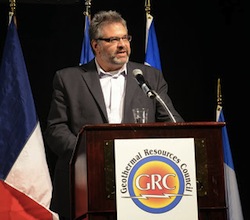The government is shut down and rumors abound about ethanol and the 2014 Renewable Volume Obligations (RVOs) to be set by the Environmental Protection Agency (EPA) as part of the Renewable Fuels Standard (RFS). 2014 RVOS are anticipated to be announced within the next few weeks. With speculation and misinformation circulating at breakneck speeds, I went to Bob Dinneen, President and CEO of the Renewable Fuels Association (RFA), who noted there was no “adult supervision” in Washington, D.C. right now, to give the country a much needed RVO 101 lesson.
“Every year EPA has got to set the Renewable Volume Obligation, or RVO, based on the amount of renewable fuel they believe will be produced in that year,” explained Dinneen. “But there are certain constraints because there is a baseline number for renewable fuel. And for 2014 that baseline number is 14.4 billion gallons. That can’t be changed. That’s set in the statute.”
 There is great flexibility for the EPA; however, to set the numbers for advanced biofuels, biodiesel and for cellulosic ethanol, continued Dinneen who noted there is flexibility which EPA has used in the past to reduce the volumes if they do not believe there is going to be the production to meet the statutory requirements. For example, said Dinneen, for 2013 the cellulosic ethanol RVO was 1 billion gallons but because the EPA didn’t believe the volumes could be met they reduced it to 6 million gallons because that is how much the EPA estimated would be produced.
There is great flexibility for the EPA; however, to set the numbers for advanced biofuels, biodiesel and for cellulosic ethanol, continued Dinneen who noted there is flexibility which EPA has used in the past to reduce the volumes if they do not believe there is going to be the production to meet the statutory requirements. For example, said Dinneen, for 2013 the cellulosic ethanol RVO was 1 billion gallons but because the EPA didn’t believe the volumes could be met they reduced it to 6 million gallons because that is how much the EPA estimated would be produced.
However, said Dinneen, in the RVO process the EPA can’t just reset the numbers. “Congress was very clear as to how they might be able to reset the numbers and that is if only an economic hardship was determined. That’s not the process that is going on right now,” Dinneen said. Instead, there is speculation about what the 2014 RVOs might be and misinformation about where EPA is going with the numbers for next year.
The next obvious question should be, have the past and current RVOs caused obligated parties any “economic harm”? “No, not at all,” answered Dinneen. “The argument that is being made is that refiners won’t be able to blend more than 10 percent ethanol in gasoline and it would drive up the price of gasoline and they’ll have to export. The problem is that none of that is happening today. Ethanol continues to drive down the price of gasoline and there most certainly has not been any type of economic harm from this program.”
In fact, while the RFS has been in place, oil companies have still made record profits. Dinneen noted that Exxon just had their most profitable quarter ever and is the most profitable company “in the history of the universe”. In fact, even if they quit whining about the RVOs and invested in the infrastructure for E15 and E85, big oil would still continue to see record profits. Interestingly, Dinneen pointed out that if the RFS goes away, and ethanol disappears and the technological advancements being made in the advanced biofuels arena stop, the only economic harm that will happen is to consumers who have to pay even more for their gas at the pump.
“This is why the RFS was created. Because for too long oil companies have had a stranglehold on our motor transportation fuels,” said Dinneen. “The RFS is about access. The RFS is intended to wrest control of our energy future from the shareholders of Exxon, and Tesoro and the other oil companies that are just upset that they are finally losing a bit of market control. We’ve taken 10 percent of the barrel. We’re on the way to taking a third of the barrel. And the only way that is going to not occur is if EPA rewards their bad behavior. It won’t happen.”
Listen to my interview with Bob Dinneen here: Government Shuts Down, Ethanol Rumors Abound
For more information about the speculation surrounding the 2014 RVOs, click here.
 GROWMARK and local FS member companies in Illinois and Wisconsin are hosting five events this week to share information about Propane Autogas as an alternative to petroleum and compressed natural gas (CNG) fuels.
GROWMARK and local FS member companies in Illinois and Wisconsin are hosting five events this week to share information about Propane Autogas as an alternative to petroleum and compressed natural gas (CNG) fuels. 









